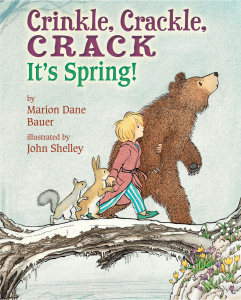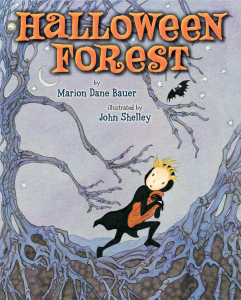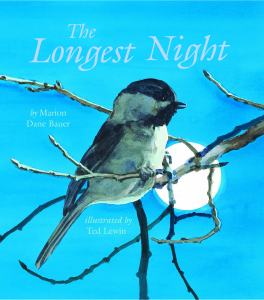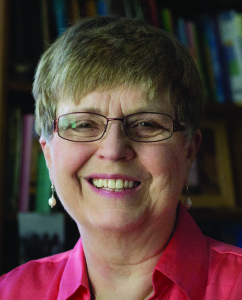National Poetry Month: Guest Post from Marion Dane Bauer: I Am Not a Poet
I am not a poet, but I do love to write verse.
I don’t make that distinction out of false humility but out of reverence for poetry and for those who create it.

Holiday House, April 2015.
True poetry requires a freshness of language, the kind of unexpected encounter with words that can make the hair rise on the back of your neck. A longtime friend of mine, the poet Barbara Esbensen, used to talk to children about bringing two words together that had never met one another before. I can do that once in a while, but the encounter requires a fair amount of serendipity.
What I can produce intentionally and reliably is work that is lyrical. I revel in rhythm and sound and the shape of the words on the page. I can write succinctly, too, and with close attention to what is left out, the unspoken that will resonate in my reader’s psyche.
Picture books, every picture book worthy of the multiple readings young children so often call for, use all of these techniques. And they are, of course, the techniques of poetry whether they reach the full status of poetry or not.
My most recent picture book, CRINKLE, CRACKLE, CRACK: It’s Spring!, illustrated by John Shelley (Holiday House), is a case in point.
I work with sound, lots of sounds. Not just the sounds that the characters pursue, trying to find their source: “crinkle, crackle, crack, rap, bap, tap, crunch, scrunch.” But I let the sounds of the more ordinary words telling the story flow for reader and listener alike: “You’d pop out of bed, / you’d creep to the door, / then you’d step outside to see . . . / mud, / rotten snow, /trees shivering in the dark.” Note the repetition of p’s followed by the sudden stop of “mud, rotten snow,” etc.

Holiday House, September 2012.
I toss in an occasional free-floating rhyme, too. “And oh . . . of course, / the bear. / The one standing there / in the middle of your yard.” When I’m writing board books for the very young, I usually work in a predictable rhythm and rhyme scheme: “How do I love you? / Let me count the ways. / I love you as the sun / loves the bright blue days.” (from HOW DO I LOVE YOU? illustrated by Caroline Jayne Church, Scholastic, 2009). But for slightly older readers such as those for CRINKLE, CRACKLE, CRACK, I prefer a more free-flowing line. “The bare bones of trees / stand on a hill / in the chill / breeze.” or “And together they’ll cry, / ‘Take care! / Beware! / Despair! / You can bet / you’ve just met / your worst nightmare!’” (from HALLOWEEN FOREST, illustrated by John Shelley, Holiday House, 2012).
The fact that I was playing with rhyme in that unpredictable way seemed to disconcert reviewers until my editor had the wisdom to use the jacket copy to provide information about the text. She referred to the text as “unmetered, rhymed verse.” Once given a name for what they were reading, reviewers quoted that phrase in their reviews and complaints fell away.
Perhaps the most important technique of poetry that picture books use is resonance. It’s the iceberg effect: 10 percent above the surface and 90 percent below. Of course, the text must hold back, leaving room for an illustrator to bring his or her own magic to the story; but the text needs to do what any good poem does as well, leave room for the one who receives the words to feel.

Holiday House, August 2009.
Resonance is more difficult to demonstrate without giving the entire text, but I’ll risk a brief example from another of my picture books, THE LONGEST NIGHT, illustrated by Ted Lewin (Holiday House, 2009). It opens this way: “The snow lies deep. / The night is long and long. / The stars are ice, the moon is frost, / and all the world lies still. / Bears sleep, as do the velvet mice. / A moon shadow lies by every tree, / thin as a hungry wolf. / ‘Sha-a-a,’ whines the wind, the bitter wind. / Cold and dark now rule. / Cold and dark now rule.”
If that text doesn’t induce an almost physical shiver, I’m not doing my job.
I’ll say it again. I don’t claim the name of poet for myself or call my work poetry, but the techniques of poetry enrich everything I create, especially when I am writing for the very young.
It is, after all, these techniques that make a story work through the multiple readings young listeners often crave. They do something more as well. They prepare those same listeners for the real thing.

Marion Dane Bauer.
Marion Dane Bauer is the author of nearly 100 books ranging from board books and picture books through easy readers, both fiction and nonfiction, and middle-grade and young-adult novels. Her picture books have made the New York Times Best Seller List and have won awards such as the Golden Kite Award for the best picture book text from the Society of Children’s Book Writers and Illustrators (SCBWI) and a Mom’s Choice Award.








